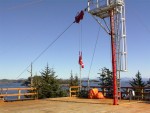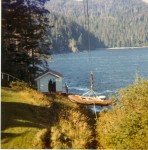
The highline (aka aerial line, or aerial) was literally the lifeline of the lighthouse in the days before helicopters. It was used and still is used to raise and lower heavy supplies to and from the lighthouse. They were not installed at all lighthouse locations – only the ones with no other access to the ocean within a reasonable distance of the station. For example Cape Scott has a highline but also has beach access but no one would want to move supplies that distance by hand or by road so a highline was built. Some other stations with highlines are Carmanah, Pachena, Cape Beale, Quatsino, Green, Pine, and Bonilla.

The highline idea originally came from west coast hillside logging where it was used to skid logs down from the mountain-sides or pull logs into a sorting area. This was usually a pulley rígged to the top of a [spar] tree through which a cable (haulback) was hooked to a steam engine to haul the trees out of the woods. The return trip was usually done manually.
The lighthouse highline was a bit more sophisticated machine consisting of a two-wheeled carriage through which the haulback (pulling/lifting) cable travelled lifting and securing the hook. The carriage travelled on a stiff wire fixed to the landward end, over the top of a mast, to an anchor in the earth. The seaward end was anchored to a rock or cement pillar in or near the ocean and usually crossed over an inlet or bay, providing access for the workboats. These lines were anywhere from 400 – 1000 feet in length and were at varying degrees of slope from the almost horizontal one at Ivory Island to the long steep ones at Carmanah, Pachena and Cape Scott.

The operation was simple – the carriage travelled by gravity down the line and was pulled back up by the haulback line attached to a winch drum in the winch shed. The winch engine was gas or diesel. Downward motion of the carriage speed was controlled by a brake on the winch drum. Engagement of the drum was controlled by a manually-operated clutch. At the top and bottom of the highline were stops to halt and hold the carriage in position while the hook released and travelled downwards or upwards.
The operation of the carriage itself was all mechanical and relied on springs (originally) and then bungy cord (elastic cord) to control the movement of the various trip levers. The bungy was the better choice as it did not stretch out of shape and lose its springyness (it didn’t stretch out of shape) which could result in a load falling from the hook, usually into the ocean!. The maximum lift weight for the highline apparatus was originally 1000 pounds but later strengthened to 1700 pounds.
On some stations like McInnes Island the highlines were installed before any other equipment, as this was the only way to move the building supplies up onto the island. In fact McInnes had two highlines installed – one to move supplies up from the ship to the top of the island and another stretching across the island so that building supplies could be moved to build the light tower and engine room and the dwellings. See the article on the building of McInnes Island.
With the highline the lightkeeper could move all of his furnishings off and on the station when transferring to another lighthouse. He could also bring in the monthly groceries from the workboat, deliver the outgoing mail and other things being shipped into the depot. He could bring up building equipment such as lumber and cement, sheet metal, and rolls of insulation. He could move the diesel engines out to the ship when worn out and bring in a new one. He could also raise and lower a small boat so he could go fishing. The highline had fixed stops on the line at top and bottom but a knowledgeable operator could drop or pickup a load anywhere throughout the length of the line. He could move loads of material from the landing deck to the ground for storage and then back again onto the deck for use.
A very useful piece of equipment!
The following gallery shows the operation of the highline at McInnes.
[nggallery id=49]